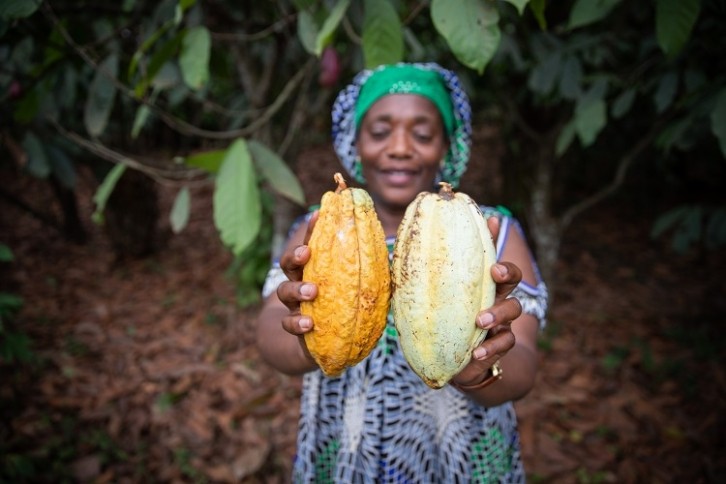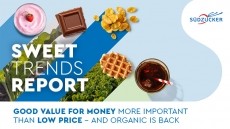Why cocoa farmers don’t earn a living income

Many farmers working in the cocoa sector do not earn living incomes. In fact, only 13% of cocoa farming households in Côte d'Ivoire earn a living income, according to the Rainforest Alliance. In neighbouring Ghana, it’s even fewer, at 10%, according to Oxfam America.
Some corporate initiatives, such as Nestlé’s Income Accelerator Programme, have been put in place to help cocoa farmers increase their incomes. Farmer cooperatives have also been set up to give farmers more negotiating power in on-the-ground prices. Some brands, such as Tony’s Chocolonely, aim to pay farmers more.
But a low percentage of farmers earning living income is still persistent in the industry. What are the key causes of this disparity, and how can they be mitigated?
What is living income?
Living income for cocoa farmers is, in essence, the ability for them to earn enough money for all members of a household to live life at a decent standard.
Cocoa farmers’ living income is calculated through a Living Income Reference Price (LIRP). Fairtrade, for example, calculated this to be, as of October 2022, a farmgate price of $2.12 (€1.94) per kilogram for Ghana and $2.39 (€2.18) for Côte d'Ivoire. However, Fairtrade’s price assumes a productivity of 800 kg/ha per year, and yields may not always produce this. Some chocolate companies, such as Tony’s Chocolonely, have adopted the LIRP.
For farmers themselves, the concept of living income isn’t known about widely. As a concept, benchmark and approach, Stefan Petrutiu, advisor at the Dutch non-profit applied knowledge institute, the KIT Institute, told FoodNavigator, living income is unknown to farmers. It is, in essence, a ‘top-down’ construct. Tony’s Chocolonely, according to Petrutiu, has tried to raise awareness of this benchmark with farmers.
The role of cooperatives
Many cocoa farmers in Ghana and Côte d'Ivoire are members of cooperatives. Cooperatives negotiate farmgate prices rather than leaving it up to individual farmers, representing their members in the transaction.
Large companies such as raw materials major OFI also use cooperatives to train farmers in new agricultural practices, like pruning, which are often used to increase yields.
What are the barriers for farmers to achieving living income?
There are several root causes to low levels of living income among farmers. Low farmgate prices are still an issue in the industry, Cedric Steijn, advisor at the KIT Institute, told FoodNavigator, and does not reflect either the cost of production or farmers’ cost of living.
This is combined with small farm size (average farm size used to produce cocoa in Ghana is 3.65ha and 4.17 ha in Côte d’Ivoire) and an even lower median farm size (meaning most farmers operate below the average farm size). Thus, yields are often too low for a living income. Those who do earn living income often have more land, and thus larger yields to sell, as well as the means to invest in their farm.
Yields are indeed the essence of low income. Yields are commonly 400-500kg/ha, Steijn told FoodNavigator, well below the 800kg/ha which Fairtrade’s LIRP works on the basis of. According to Steijn, this has the potential to be up to 1000kg/ha.
There are a range of reasons for this. Among these include the effects of climate change and unpredictable weather patterns on yields, as well as crop pests such as black pod rot, capsids, mistletoe and most importantly Cocoa Swollen Shoot Virus Disease (CSSVD), known locally as ‘the AIDS of cocoa’, which has the potential to cause 15-50% yield loss (a common solution to this disease in the past was to uproot a whole farm and not grow in the same spot for three years).
Another key limiting factor for farmers is simply lack of money to invest in farms in order to increase yields. For example, when cocoa trees age and no longer produce as abundantly, replacing them with new trees (which would take three to five years to become productive) is not viable for farmers, who often do not have income to survive this period. Thus, they stick with older trees.
Many additional limitations also exist in regards to costs. “Farmers are unable to hire labour to perform all tasks such as weeding and pruning, and cannot afford inputs such as fertilizers and chemicals. Inability to afford labour disproportionately affects older farmers and female-headed households,” Steijn told us. Inability to invest in these things means a lower yield, and thus lower income. The cycle continues.
Alongside these more consistent constants, the cost-of-living crisis has of late made living costs even more expensive for farmers, meaning that it’s harder to afford basic necessities. Local costs of living, such as food, housing, healthcare and education, are not connected to cocoa prices, Petrutiu told us, and so can shoot up without income increasing to cover them.
Finally, illegal goldmining in Ghana often encroaches on cocoa land, harming farmers’ ability to cultivate the crop.
What are the main barriers facing industry in achieving it?
Industry has implemented several programmes in recent years to help boost incomes as sustainability, a term which covers human as well as environmental issues, has become more prominent both legislatively and as a topic of conversation. However, the issues at hand are complex.
“There is a limit to the kind of transformational impact that any one company or government can have on a complex problem like living income. Consensus for a globally accepted methodology requires time, and specific norms and methods may vary from region to region,” Yves-Pascal Suter, global social sustainability lead at ingredients supplier OFI, told FoodNavigator. However, collaboration is key.
Legislation such as the newly passed Corporate Sustainability Due Diligence Directive (CSDDD), he told us, could help create the environment for industry to adopt measures to close the income gap and get farmers further towards living income.
While living income as been on the agenda for a while now, barriers still present themselves to its full implementation.

“Unfortunately, even though a first LI conference took place perhaps ten years ago, cocoa buyers and traders are still learning about how to scale effective interventions to the poorest producing households,” KIT’s Petrutiu told us.
Industry efforts to improve farmer income come in three main forms: initiatives to improve yields through different agricultural practices and diversification, pricing interventions, and cash transfers.
Private sector partnerships on good agricultural practices, according to Steijn, often fall short because the private sector does not yet assume responsibility or make commitments specific to diversifying farmers or transitioning them into other businesses or jobs. “This is critical especially for families whose farms’ total production and a LIRP or other LI-interventions are insufficient for them to ever earn a LI."
Pricing interventions usually consist of a premium paid on top of the farmgate price. This rarely enough to close the gap to living income. It is, however, sometimes calculated in reference to Fairtrade’s LIRP. Companies who do this include Tony’s Chocolonely, Aldi and Unilever-owned Ben and Jerry’s.
However, according to Steijn, this is limited by the fact it’s based on a level of production which, because of either small land size or poor yields, isn’t always reached.
What is the role of commodity markets?
Commodity exchanges, on which many commodities, including cocoa, are traded, do not directly affect the price on the ground, according to Expana's (formerly Mintec Global) Andrew Moriarty. However, they can influence it. Having access to commodity prices can also put farmers in a better position to negotiate.
KIT’s Stefan Petrutiu, after interviewing several industry key players, suggested that there were conflicting views in industry about the influence of commodity pricing.
“Those involved in purchasing perceive the LIRP or other pricing interventions related to a LI as a hindrance. On the other hand, sustainability managers in the same companies, or smaller sustainability-oriented companies who only use commodity market prices as a reference, see the commodity market as a hindrance,” he told us.
Finally, there are cash transfers in return for the adoption of specific practices, of the kind adopted by such as Nestlé’s Income Accelerator programme. The programme is “aiming to close the living income gap and address child labour risks by encouraging changes in cocoa producers’ behaviour and rewarding positive practices – both within the home and on the farm,” Darrell High, cocoa manger at Nestlé, told FoodNavigator.
However, according to Petrutiu, the routes to living income from similar initiatives are far from certain. “It is still unclear what percentage of farmers in its supply chain will achieve a living income as a result of this intervention,” he told us. “Still, early results show that it impacts farmers’ income at scale.”
Some industry players are working towards gauging the level of living income gap, in order to better understand what can be done to change it.
OFI, for example, has developed a ‘Living Income Calculator,’ Suter told us, that aims to identify living income gap hotspots in cocoa (as well as coffee and chilli) supply chains and has worked with the Sustainable Food Lab and the Living Income Community of Practice to make it available to the sector. The company has also created a ‘Farmer Income Tool’ for cocoa specifically, which aims to estimate farmer income at a household level.
What is the role of national governments in cocoa-producing countries?
In key cocoa producing countries Ghana and Côte d'Ivoire, the farmgate price is set by the national governments. Their cocoa sectors are regulated by the Ghana Cocoa Board (COCOBOD) in Ghana and the Conseil Café Cacao (CCC) in Côte d'Ivoire.

These bodies set the price, KIT’s Petrutiu told us, through forward sales of around 70-80% of the cocoa produced, at a price based on export price and linked to price forecasts and world price. While it offers a ‘guaranteed and stable price to cocoa farmers’, it is heavily taxed in both countries. Farmers get 70% of the export price in Ghana and 60% in Côte d'Ivoire.
However, he suggested that such regulation doesn’t necessarily end up with better farmer incomes. “There is no evidence that this price policy leads to a higher cocoa price compared to farmers in non-regulated markets, mainly due to the high tax and inefficient reinvestment of the taxes back in to the cocoa sector. Reinvestments have not led to a tangible increase in productivity for farmers.”
What would happen if all cocoa farmers had a living income?
In an ideal world, if all cocoa farmers earned a living income, how much would consumers pay for chocolate? Would this lead to price increases?
Firstly, Petrutiu suggested, not all farmers should be paid a living income, as this would mean that farmers with very low production would receive a living income from planting only a few trees (issues like this is what measures such as LIRP, based on 800kg/ha, work to solve).
However, if they were all to earn a living income, he doesn’t predict that industry would push consumer prices up that much, as price differences would be absorbed elsewhere in the value chain.
“Less known companies, for example in emerging economies, would only adopt LI targets if pushed by legislation. If the industry adopts LI commitments at scale, the financial hit can be absorbed by effective interventions paid through existing sustainability budgets or through the existing profits from downstream value chain actors.”
Manufacturers and brands, Steijn added, will often offset price increases by using cheaper alternatives. When prices rose in 2023, “manufacturers and brands responded by reducing the amount of cocoa in their chocolate products and adding cheaper alternatives such as hazelnut paste and whey powder.”






































